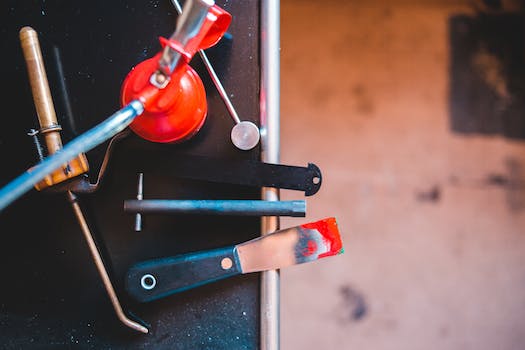
The Role of 3D Printing in Manufacturing, Healthcare, and Design
-
Table of Contents
- Introduction
- Exploring the Potential of 3D Printing in Manufacturing: How It Can Revolutionize the Industry
- The Impact of 3D Printing on Healthcare: How It Can Improve Patient Care
- Designing with 3D Printing: How It Can Enhance Product Development
- The Benefits of 3D Printing in Manufacturing: Cost Savings and Efficiency Gains
- The Future of 3D Printing in Healthcare: How It Can Transform Diagnostics and Treatment
- Q&A
- Conclusion
“Unlock the Possibilities of 3D Printing: Revolutionizing Manufacturing, Healthcare, and Design”
Introduction
3D printing is a revolutionary technology that has the potential to revolutionize the way we manufacture, design, and provide healthcare. It has the potential to revolutionize the way we create products, from medical devices to consumer goods. 3D printing has the potential to reduce costs, increase efficiency, and create new opportunities for innovation. In this article, we will explore the role of 3D printing in manufacturing, healthcare, and design. We will discuss the advantages and disadvantages of 3D printing, as well as the potential applications of this technology in the future. We will also discuss the challenges that must be overcome in order for 3D printing to reach its full potential.
Exploring the Potential of 3D Printing in Manufacturing: How It Can Revolutionize the Industry
The manufacturing industry is undergoing a revolution, and 3D printing is at the forefront of this transformation. 3D printing, also known as additive manufacturing, is a process of creating three-dimensional objects from a digital file. This technology has the potential to revolutionize the manufacturing industry by providing a more efficient, cost-effective, and sustainable way to produce products.
The most significant benefit of 3D printing is its ability to reduce production costs. By eliminating the need for expensive tooling and molds, 3D printing can significantly reduce the cost of producing a product. Additionally, 3D printing can reduce the time it takes to produce a product, as it eliminates the need for manual labor and can produce complex parts in a fraction of the time.
3D printing also offers a more sustainable approach to manufacturing. By eliminating the need for large amounts of raw materials, 3D printing can reduce waste and conserve resources. Additionally, 3D printing can reduce the amount of energy used in the production process, as it requires less energy to produce a product than traditional manufacturing methods.
Finally, 3D printing can also provide manufacturers with greater flexibility. By allowing manufacturers to quickly and easily produce custom parts, 3D printing can enable manufacturers to quickly respond to customer demands and produce products that meet their exact specifications.
As the technology continues to evolve, 3D printing is becoming increasingly accessible and affordable. This means that more and more manufacturers are beginning to explore the potential of 3D printing and are finding ways to incorporate it into their production processes.
The potential of 3D printing in manufacturing is clear. By providing a more efficient, cost-effective, and sustainable way to produce products, 3D printing has the potential to revolutionize the manufacturing industry. As the technology continues to evolve, it is likely that 3D printing will become an increasingly important part of the manufacturing process.
The Impact of 3D Printing on Healthcare: How It Can Improve Patient Care
3D printing has revolutionized the healthcare industry, offering a range of benefits that can improve patient care. This technology has the potential to revolutionize the way medical professionals diagnose and treat patients, as well as how they interact with them.
3D printing can be used to create custom medical devices, such as prosthetics, implants, and orthotics. This technology allows medical professionals to create devices that are tailored to the individual patient’s needs, which can improve the patient’s comfort and quality of life. 3D printing also allows for faster production of medical devices, which can reduce wait times for patients.
3D printing can also be used to create models of organs and tissues, which can be used to help medical professionals diagnose and treat patients. These models can be used to practice surgical procedures, as well as to plan and practice treatments. This can help medical professionals to be better prepared for the actual procedure, which can improve patient outcomes.
3D printing can also be used to create personalized medications. This technology can be used to create medications that are tailored to the individual patient’s needs, which can improve the effectiveness of the treatment. This can also reduce the risk of side effects, as the medication is tailored to the patient’s specific needs.
Finally, 3D printing can be used to create educational materials for patients. This technology can be used to create models of organs and tissues, which can be used to help patients better understand their condition and treatment options. This can help to improve patient compliance and understanding of their treatment, which can lead to better outcomes.
Overall, 3D printing has the potential to revolutionize the healthcare industry and improve patient care. This technology can be used to create custom medical devices, models of organs and tissues, personalized medications, and educational materials. All of these benefits can help to improve patient outcomes and quality of life.
Designing with 3D Printing: How It Can Enhance Product Development

3D printing has revolutionized the way products are designed and developed. It has enabled engineers and designers to create complex parts and products with greater accuracy and speed than ever before. With 3D printing, product development teams can quickly prototype and test new designs, allowing them to iterate and refine their products faster than ever before.
The ability to quickly and accurately create 3D models of products has enabled product development teams to explore new design possibilities. By using 3D printing, engineers and designers can create complex parts and products with intricate details that would be difficult or impossible to create with traditional manufacturing methods. This allows them to create products with unique shapes and features that can give them a competitive edge in the market.
3D printing also allows product development teams to quickly and easily test their designs. By printing out prototypes of their products, they can quickly identify any design flaws or areas that need improvement. This allows them to make changes and adjustments to their designs before they go into production, saving time and money in the long run.
Finally, 3D printing can also be used to create custom parts and components for products. By printing out custom parts, product development teams can create products that are tailored to their specific needs. This can be especially useful for creating products that require unique components or features that are not available off-the-shelf.
Overall, 3D printing has revolutionized the way products are designed and developed. It has enabled product development teams to quickly and accurately create complex parts and products with intricate details. It has also allowed them to quickly and easily test their designs and create custom parts and components for their products. By leveraging the power of 3D printing, product development teams can create innovative products that give them a competitive edge in the market.
The Benefits of 3D Printing in Manufacturing: Cost Savings and Efficiency Gains
3D printing has revolutionized the manufacturing industry, offering cost savings and efficiency gains that are hard to ignore. This technology has been around for decades, but it has only recently become more accessible and affordable for businesses of all sizes.
3D printing offers a number of advantages over traditional manufacturing methods. For starters, it is much faster and more cost-effective. 3D printing can produce complex parts in a fraction of the time it would take to produce them using traditional methods. This means that businesses can produce more parts in less time, resulting in significant cost savings.
In addition, 3D printing is much more efficient than traditional manufacturing methods. It eliminates the need for tooling and other costly processes, allowing businesses to produce parts with fewer resources. This can result in significant savings in both time and money.
3D printing also offers businesses the ability to produce parts with greater accuracy and precision. This is especially important for businesses that require parts with tight tolerances. With 3D printing, businesses can produce parts that are more accurate and consistent than those produced using traditional methods.
Finally, 3D printing is much more flexible than traditional manufacturing methods. It allows businesses to quickly and easily produce parts in a variety of shapes and sizes. This means that businesses can produce parts that are customized to their exact specifications, resulting in greater efficiency and cost savings.
Overall, 3D printing offers businesses a number of advantages over traditional manufacturing methods. It is faster, more cost-effective, and more efficient, resulting in significant cost savings and efficiency gains. As 3D printing technology continues to evolve, businesses will continue to reap the benefits of this revolutionary technology.
The Future of 3D Printing in Healthcare: How It Can Transform Diagnostics and Treatment
The healthcare industry is on the cusp of a revolution, and 3D printing is at the forefront of this transformation. 3D printing has the potential to revolutionize the way we diagnose and treat medical conditions, from prosthetics to implants and even organs.
3D printing has already been used to create prosthetics, implants, and even organs. Prosthetics can be designed to fit a patient’s exact specifications, and implants can be tailored to fit the exact shape and size of the patient’s body. 3D printing can also be used to create organs, such as a heart or a kidney, which can be used to replace a damaged organ.
3D printing can also be used to create medical devices, such as stents, catheters, and pacemakers. These devices can be designed to fit the exact specifications of the patient, and can be printed quickly and cost-effectively.
3D printing can also be used to create personalized medications. By using 3D printing, medications can be tailored to the exact needs of the patient, ensuring that they get the most effective treatment possible.
Finally, 3D printing can be used to create medical models, which can be used to help doctors diagnose and treat medical conditions. These models can be used to simulate a patient’s anatomy, allowing doctors to better understand the condition and develop a treatment plan.
The potential of 3D printing in healthcare is immense, and it is only just beginning to be explored. As technology advances, 3D printing will become even more powerful and versatile, allowing us to create more complex medical devices and treatments.
3D printing has the potential to revolutionize the way we diagnose and treat medical conditions, and it is only a matter of time before it becomes a standard part of healthcare. As 3D printing technology continues to evolve, it will become an even more powerful tool for healthcare professionals, allowing them to provide better care for their patients.
Q&A
Q1: What is 3D printing?
A1: 3D printing is a process of creating three-dimensional objects from a digital file. It is also known as additive manufacturing, as it builds up objects layer by layer.
Q2: How is 3D printing used in manufacturing?
A2: 3D printing is used in manufacturing to create complex parts and components quickly and cost-effectively. It can also be used to produce custom parts and prototypes, as well as to reduce waste and improve efficiency.
Q3: How is 3D printing used in healthcare?
A3: 3D printing is used in healthcare to create custom medical implants, prosthetics, and surgical tools. It can also be used to create models of organs and tissues for medical training and research.
Q4: How is 3D printing used in design?
A4: 3D printing is used in design to create prototypes and models quickly and cost-effectively. It can also be used to create custom parts and components for products and projects.
Q5: What are the benefits of 3D printing?
A5: The benefits of 3D printing include cost savings, faster production times, improved accuracy, and the ability to create complex parts and components. It also reduces waste and allows for customization of products and parts.
Conclusion
In conclusion, 3D printing has revolutionized the way we manufacture, design, and provide healthcare. It has enabled us to create complex and intricate designs with greater accuracy and precision than ever before. It has also allowed us to produce products faster and more cost-effectively. 3D printing has also enabled us to create customized medical devices and prosthetics, as well as to produce medical implants and other medical products with greater accuracy and precision. Finally, 3D printing has enabled us to create unique and innovative designs for products and services that would have been impossible to create with traditional manufacturing methods. 3D printing is an exciting and rapidly evolving technology that is sure to continue to revolutionize the way we manufacture, design, and provide healthcare.






